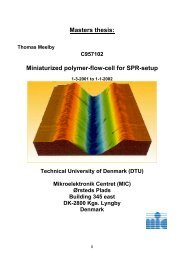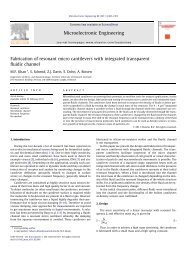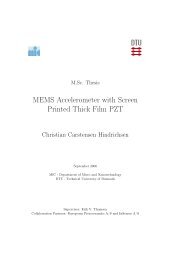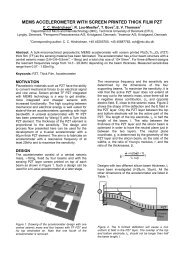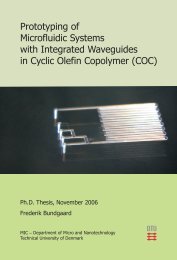C - DTU Nanotech - Danmarks Tekniske Universitet
C - DTU Nanotech - Danmarks Tekniske Universitet
C - DTU Nanotech - Danmarks Tekniske Universitet
Create successful ePaper yourself
Turn your PDF publications into a flip-book with our unique Google optimized e-Paper software.
2 Overview of Small–Scale Cultivation<br />
Systems<br />
This chapter gives a short overview of the performance of commercial available and currently<br />
developed small–scale cultivation systems.<br />
2.1 Shaken small–scale cultivation systems<br />
Most of the initial culture experiments in biotechnology are performed in shaken small–scale<br />
systems [4]. Erlenmeyer flasks, test–tubes and microtiter plates belong to this class of shaken<br />
small–scale systems.<br />
The size of Erlenmeyer flasks is very variable, but the nominal volume normally ranges<br />
between 25 ml and 5 l. They are made of borosilicate glass (hydrophilic) or polymer (hy-<br />
drophobic) and are equipped with or without baffles. For the liquid mixing at defined<br />
temperatures orbital shaking devices in incubators are usually used. Dissolved oxygen can<br />
be measured with an integrated electrochemical O2 sensor or with a new developed opti-<br />
cal sensor system, which allows a robust and precise online measurement [45]. Hereby, an<br />
immobilized small sensor spot at the bottom of the flask is irradiated by fluorescent light<br />
and fluorescence quenching or decay time is sensed [23]. Because of the oxygen limitation in<br />
shaken flasks, various modifications like baffles and steel springs or other enhancements to<br />
improve aeration have been developed [5, 15, 42]. The pH is usually kept within acceptable<br />
range by using buffers, whereas pH excursions might occur without being observed [23].<br />
But recently new developed shaken flasks with inserted pH probes have been described for<br />
measurement and control of pH [44, 42].<br />
Test–tubes are primarily used for various screening applications and are useful for de-<br />
veloping inoculums for small–scale fermentations. Normally the volumes are ranging from<br />
about 2 − 25 ml and the tubes are made of glass or polymer. For maintaining the steril-<br />
ity of the culture, the opening of the tube is fitted with a cotton or a plastic foam plug.<br />
Test–tube devices are also used for anaerobic cultivation where the O2 concentration is kept<br />
below the critical values with evacuation and steel–wool plugs [37]. To use test–tubes for<br />
13



